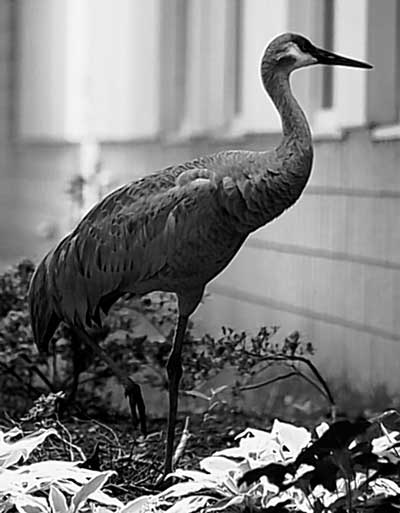VA Mystery Bird Not One For Long: Photo
Posted by: Loren Coleman on May 17th, 2009
“What-Is-It?” ~ people had been asking about a strange bird being seen around a coastal section of Virginia. Then people started taking photographs, like this one.
Bob Hume had a big surprise driving up Colley Avenue in Norfolk recently when he had to slow down to avoid hitting a large bird ambling across the street, wrote Mary Reid Barrow at The Virginian-Pilot on May 17, 2009.
“I slowed to miss it and realized with a shock that I was staring at a sandhill crane,” Hume wrote. “I had seen a couple before in south Florida, but I knew very well they are nowhere close to being local to this area.”
Hume, who lives on Hanover Avenue, would have been hard-pressed to confuse this long-necked, long-legged bird with anything else. Stylish and graceful, sandhill cranes are almost 4 feet tall and sport a handsome red crown.
He stopped traffic to let the bird cross the street, then tried to take its photo with his cell phone.
Hume may have been among the first in town to spot the first sandhill crane ever reported in Norfolk. David Clark, president of the Cape Henry Audubon Society, said no record of a sandhill crane exists in the city.
The bird later made its presence well known by spending a day outside the WHRO television studios on Hampton Boulevard, said Wendy Hazel, WHRO’s Education Office manager. (See photo at top.)
“At first, it wandered around the parking lot and then found a nice shady spot in the flower bed outside of the office of Bert Schmidt, our president and CEO,” Hazel wrote in e-mail.
“WHRO staff started referring to the crane as either Big Bird or Ernie (since he seemed to want to be near Bert)!” she added.
Several members of the Cape Henry Audubon Society, including Clark, who lives nearby, came to see the bird and photograph it.
It appeared to be checking its image in Schmidt’s office window, perhaps seeking a mate or hoping to drive off a possible competitor.
Most sandhill cranes migrate between Texas and New Mexico and Canada, but Norfolk’s crane probably was one of a smaller group that breeds in the Great Lakes area and winters in Florida, Clark speculated. It may have flown off course on its migration back to its breeding grounds.
“Some wander a bit,” Clark said. “A few hundred miles for a bird like a sandhill crane is no big deal.”
Clark checked “Virginia’s Birdlife: An Annotated Checklist,” a publication of the Virginia Society of Ornithology, which notes that recorded sightings of sandhill cranes in Virginia over the years have been rare. Most sightings have been from the Eastern Shore, and three have been from the Back Bay area of Virginia Beach.
“It’s nice to be able to add Norfolk to that list,” Clark said.
And it also would have been nice for Clark to have been able to add the crane to his list of backyard birds, an opportunity he missed by just six blocks!
Later in the week, the crane was again spotted wandering on Colley Avenue, in danger of being hit by a car.
Volunteers from Wildlife Response captured it and took it to wildlife rehabilitator Lisa Barlow in Virginia Beach, who found the bird to be “underweight but very active and alert.”
After a few days on a healthy diet, the crane was successfully released into the wild, writes Mary Reid Barrow.
About Loren Coleman
Loren Coleman is one of the world’s leading cryptozoologists, some say “the” leading living cryptozoologist. Certainly, he is acknowledged as the current living American researcher and writer who has most popularized cryptozoology in the late 20th and early 21st centuries.
Starting his fieldwork and investigations in 1960, after traveling and trekking extensively in pursuit of cryptozoological mysteries, Coleman began writing to share his experiences in 1969. An honorary member of Ivan T. Sanderson’s Society for the Investigation of the Unexplained in the 1970s, Coleman has been bestowed with similar honorary memberships of the North Idaho College Cryptozoology Club in 1983, and in subsequent years, that of the British Columbia Scientific Cryptozoology Club, CryptoSafari International, and other international organizations. He was also a Life Member and Benefactor of the International Society of Cryptozoology (now-defunct).
Loren Coleman’s daily blog, as a member of the Cryptomundo Team, served as an ongoing avenue of communication for the ever-growing body of cryptozoo news from 2005 through 2013. He returned as an infrequent contributor beginning Halloween week of 2015.
Coleman is the founder in 2003, and current director of the International Cryptozoology Museum in Portland, Maine.











These began migrating back into Michigan several weeks ago. We always see many of them throughout the fields this time of year.